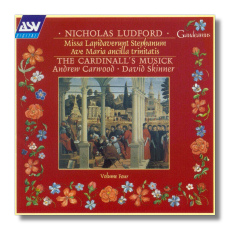
The Internet's Premier Classical Music Source
Related Links
- Ludford Reviews
- Latest Reviews
- More Reviews
-
By Composer
-
Collections
DVD & Blu-ray
Books
Concert Reviews
Articles/Interviews
Software
Audio
Search Amazon
Recommended Links
Site News
 CD Review
CD Review
Nicholas Ludford

Sacred Music - Volume IV
- Missa Lapidaverunt Stephanum
- Ave Maria ancilla trinitatis
The Cardinall's Musick/Andrew Carwood
Produced by David Skinner
Academy Sound & Vision Gaudeamus GAU 140 DDD 69:18
This is, short of any unexpectedly joyous discoveries, the last instalment in AS&V's revelatory four-CD series of the festal masses of Nicholas Ludford. What has happened instead is that the revelations during the course of this series have been both of Ludford's music, for the thousands who must have encountered it for the first time through these discs, and about Ludford himself, with the uncovering of a number of documents detailing his life and career. Previously, little more was known about Ludford than that he worked in the chapel of St. Stephen's at Westminster. Now the detail that David Skinner has to offer takes up two-and-a-half columns of his notes, and that is a summary of his longer article in Early Music (the details are given in a footnote).
I was first alerted to the magnificence of Ludford's music in a 1984 BBC broadcast in a Christmas series that went under the title of The Octave of the Nativity. I had been impressed, even moved by many of the broadcasts, but Ludford's music for "The Procession and Mass of St. Stephen, as they might have been conducted in the Chapel of St. Stephen in the Palace of Westminster on Sunday 26 December 1529" was a knock-out, and I became an eager advocate. (Peter Phillips, for example, probably began to realise that the downside of a Tallis Scholars' concert in St. John's, Smith Square, in central London would be getting his ear bent in the Marquis of Granby afterwards.) That mass setting, the Missa Lapidaverunt Stephanum ("They stoned Stephen"), is the one that AS&V has now reached (coupled here with his setting of the Marian prayer Ave Maria ancilla trinititas). It is the crowning achievement in the series, sonorous and sumptuous, and again underlining Ludford's understanding of dramatic contrast - here between tutti passages that use all five voices and sections that use but two or three, between bold declamation and what Skinner calls "Eton choirbook-like melismas […] lovingly set, with harmonic invention which seems almost to anticipate 17th-century practice."
As before, Andrew Carwood's The Cardinall's Musick set the polyphony in its plainsong setting, the only way that this music makes sense. And Carwood and his singers are as acutely aware of the drama that can be found in the chant itself: listen to how they bring alive the sequentia that tells of the stoning of St. Stephen by passing the narrative from side to side and varying the vocal quality of their singing.
Likewise the academic quality of the presentation: Skinner's notes on Ludford and this mass are followed by an explanatory note that there are indeed more works (seven complete Lady masses as well as fragmentary pieces), a note of the religious significance of the St. Stephen myth, full texts and translations, notes on sources - this is as happy a marriage of scholarship and performance as you can imagine.
In short, this is a fabulous recording, which I urge you to rush out and buy. And the three before it, since AS&V should be encouraged to turn to the Lady masses next. The emotion you most often hear behind 'I told you so' is Schadenfreude; anyone who had been waiting for Ludford's star to shine before Carwood and Skinner made his case so eloquently will now be suffused by an emotion you might called Freudenfreude. If the word didn't exist before, Ludford's music is a good reason for coining it.
Copyright © 1996/1998, Martin Anderson


















